
11 minute read
Born to Fly
With a wingspan of approximately 3m the mighty Condor is one of the largest birds on earth. Tom Dickson travelled to Western Australia in 2014 to find the Agrifac selfpropelled sprayer that bears its name
Pluses
StabiloPlus chassis Comfort and ride GreenFlowPlus spray circulation Incredible vision EcoTronicPlus control monitor Front cab/rear boom configuration Auto greasing
Minuses
Steering response
I’ve tracked down a Condor WideTrackPlus in the southern grain belt of Western Australia, about an hour and a half north of Albany. The WideTrackPlus has a 5,000-litre poly tank, 36m J-boom fitted with Green Flow Plus spray delivery technology. It’s powered by a 286hp (213kW) six-cylinder Iveco diesel engine and rides on the unique and original Agrifac chassis called the StabiloPlus chassis. The company began as the maker of a simple knapsack potato sprayer in 1939, then progressed to basic linkage sprayers in 1948. In 1973, production line manufacturing of linkage and trailed sprayers began but the real leap came in 1986, with the introduction of Agrifac’s trademark StabiloPlus chassis. The chassis is still used in all the Condor range and now includes air suspension and stepless track width adjustment to fit into a variety of controlled-traffic tram track farm practices. Keep in mind tyre selection can create variations in track width. I’ve been told the StabiloPlus chassis is the most important of the Condor’s features and is the number one contributing factor to its versatility in track widths. It also maximises driver comfort and gentle boom ride. I head underneath the machine first, to find out what is so special about the trademark chassis. My first impression is how easy it is to get under, which is due to ground clearance height on the WideTrackPlus of 125cm. I’m expecting to find a complicated structure, but am pleasantly surprised at how basic and simple it is to see how everything works. It’s a walking beam type set-up. Each side beam pivots in the centre and has air bag suspension at either end where the wheels attach. The walking beam distributes the effects of bumps and undulations between the front and back wheels which in turn halves the effect on the machine. Each side beam slides in and out to allow track widths between 225cm and 300cm, or in this case 235cm and 315cm as it’s running larger 480/80 R46 Michelin tyres. The track width transformation takes only seconds to achieve while moving at slow speed and is done from within the cab via the EcoTronic touchscreen.
SKY DECK VIEW
Time to jump in and find out what it’s like to drive and if this StabiloPlus chassis really does provide a comfy ride. Due to time constraints the sprayer has already been set up ready for work by Agrifac Western Australia territory manager Mark Slater– I don’t want to get too swamped with info on how to program the computer and prefer to concentrate more on its drivability and comfort. There is nothing to fault regarding the cabin space. It has a comfy suspension seat with all the controls mounted on the armrest but this is virtually typical of all modern machinery. The vision, on the other hand, is exceptional. The cabin is mounted out the front of the chassis so there is nothing forward or to the side to obstruct my view, giving me the sensation I’m actually suspended in mid-air out the front of the machine. From here I can see virtually straight to the ground and all around. The tank, pumps and motor are behind the cab and the boom is at the rear. This configuration makes the most sense to me because it provides unobstructed vision, reduces noise levels from the engine and minimises spray mist over the cabin and windows. For the life of me I can’t see the sense in front mounted booms. With all the windows and mirrors I’m getting a great view of the boom and for those hard to see areas there are up to three onboard cameras sending images to an in-cab monitor. A nifty feature is the folding steps. By pressing a button on the
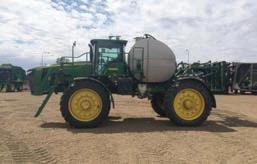
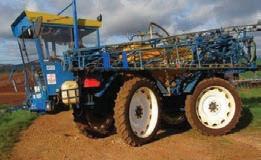
Looking for a selfpropelled sprayer?
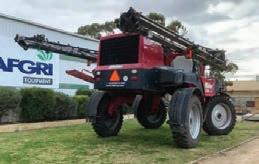
Search for ‘sprayer’ on
TradeFarmMachinery.com.au
or type the TA or DIY code shown here into the keyword search field

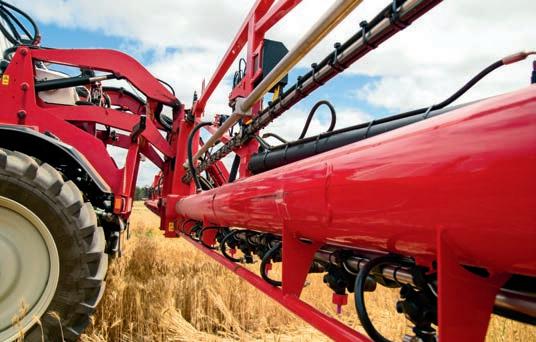
back of the handgrip controller the steps fold out of the way level with the chassis. Climate control and a modern surround sound system keep the driver as comfortable as possible and underneath the passenger seat is a heating and cooling food storage compartment.
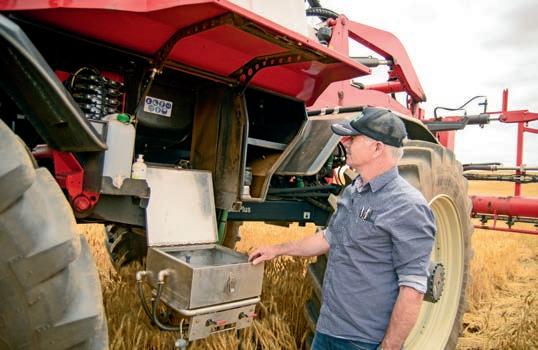
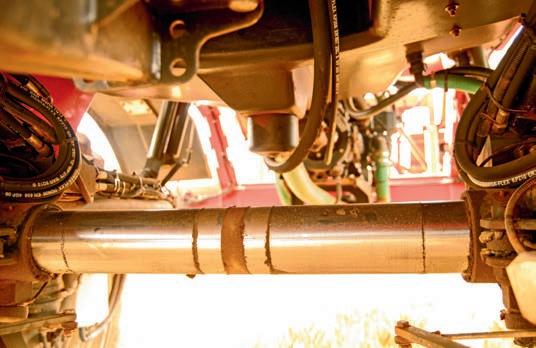
BOOSTING THE REVS
There is nothing more stressful then having to go through a heap of complex steps just to be able to get moving so I’m pleased to discover it doesn’t take a degree in rocket science to get the Condor working. In fact, quite the opposite. A turn of the key fires the 6.7-litre diesel into life then with guidance from Slater I boost engine speed up to 1,400 revs. Slater says under normal conditions this is the optimum revs to generate enough power to run the hydrostatic transmission while maximising fuel efficiency. “Fuel economy rates as low as 12 to 14 litres can be achieved at this engine speed,” he tells me. The Condor carries 270 litres of fuel, which means it could do a few long days spraying before refuel is required. We have set cruise control to 27km/h but it can be anywhere between 0km/h and 35km/h. To get the show on the road I move the joystick controller sideways out of neutral then push forward. It’s that simple. If I push it all the way forward we achieve gentle acceleration up to the pre-set cruise control speed. At 27km/h we seemed to just float along and I really don’t feel like I’m travelling that fast. The steering takes a little bit of getting used to and I expect that’s because I’m not used to driving a vehicle with hydrostatic steering. There seems to be a bit of a lag between turning the wheel and response from the steering which results in a bit of oversteering while getting used to it. Engaging reverse is similar to forward except I move the joystick backwards.
2 3
4 5
PERFECT BALANCE
Now I’m confident about the simple art of driving, the time seems right to have a crack at spraying as well. A second smaller joystick takes care of all the boom folding operations. Opening the 36m boom, which is divided into three sections either side plus a rigid middle section, is a three step process. The boom has a very gentle transition to the open position then it’s just a matter of lowering it to the pre-set operating height. Mounted at the end of each boom is a sonic sensor that maintains precise working height at all times. It can be programmed to keep equal distance from the ground or from the top of the crop. I’m cruising along at 27km/h and the boom is riding beautifully. Even while spraying around hills the boom seems to react instantly to the sensors signals and maintains perfect height. At 27km/h the 36m boom can spray about 97 hectares per hour, making fuel usage costs about 20 cents per hectare. Spraying solution is delivered from the tank to the nozzles by a system called GreenFlowPlus. This basically means chemical is supplied accurately with air assistance through the shortest amount of pipe. It has only one delivery line that flows as a continual loop running the full length of the boom then back to the tank. As the tank fill process begins, the pump begins circulating the contents of the tank throughout the whole system, ensuring mixed spray is at each nozzle at the start of the job. By eliminating all of the sectional delivery hoses the amount of unused spray left sitting in hoses along the boom is kept to an absolute minimum. There is no sectional shut off but each individual nozzle has an airline, HTA or HighTechAir that can cease flow through individual nozzles and also adjust droplet size through the
1. The Agrifac Condor WideTrackPlus boasts great ground clearance, stepless track width adjustment and unobstructed vision from the out front cabin 2. The StabiloPlus chassis slides in and out on the centre beam for stepless track widths between 225cm and 320cm 3. Hidden away under the side cover is the stainless steel induction hopper with drum rinse and fresh water spray gun 4. The J-Boom with GreenFlowPlus has only one delivery line with a return line back to the tank providing continual spray mix circulation 5. Air bag suspension on all four corners of the StabiloPlus chassis;
Agrifac Condor WideTrackPlus
Engine Iveco, six-cylinder, 286hp (213kw), Tier 4 interim with AdBlue Trans. Hydrostatic, four-wheel drive, high/low/road ranges Chassis StabiloPlus Suspension Air Steering Four-wheel/two-wheel/crab steer Track width 235cm to 315cm Capacities 121 Spray tank 5,000 litres Rinse tank 450 litres Fuel tank 270 litres
Hydraulic oil tank
80 litres Boom J-boom with GreenFlowPlus, 36m Dimensions 870 to 942cm L x 275 to 300cm W x 378 cm H
Ground clearance
125cm
Weight 9,300kg





6. The round beam on the J-Boom adds strength and durability on booms up to 51m wide 7. Daily maintenance checks are few and easy to access
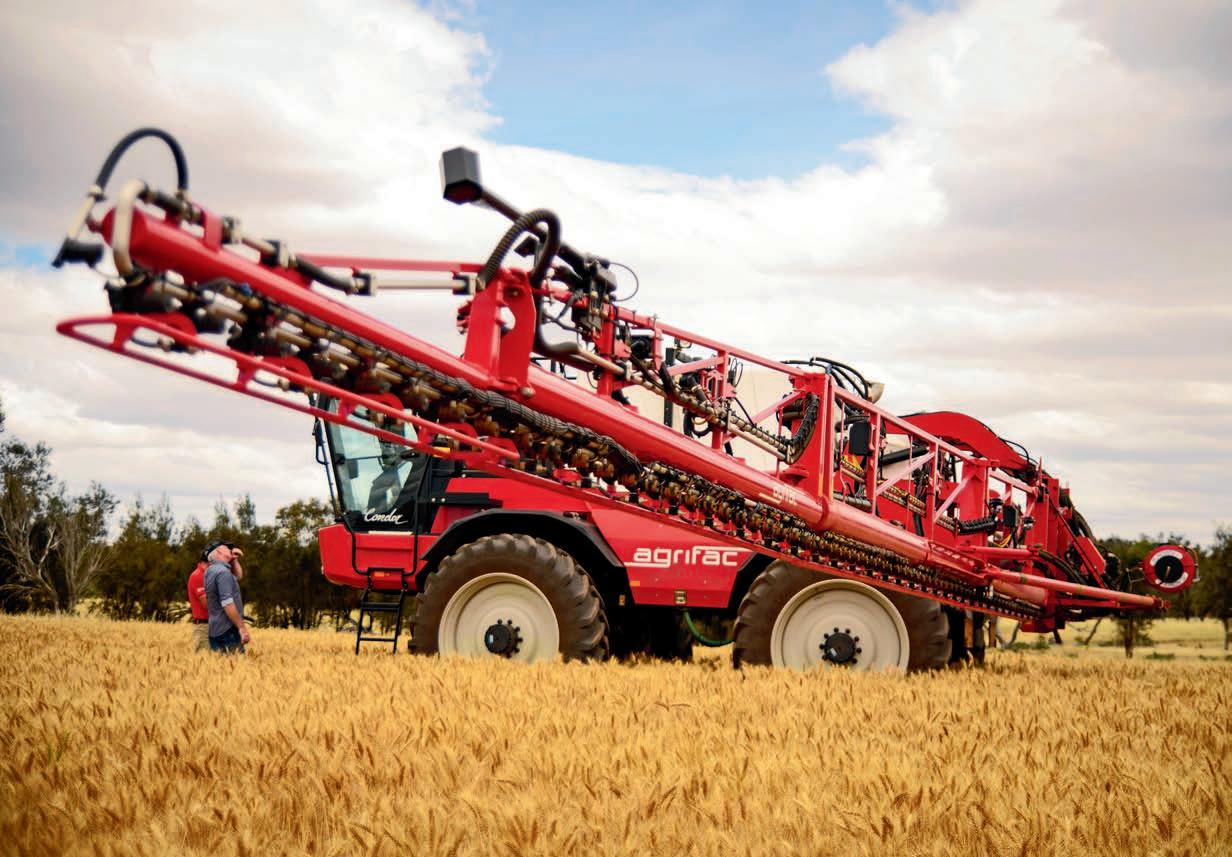
nozzles to optimise spray quality in all conditions. A few times I deliberately hang the boom out over a previously sprayed area and instantly the Trimble guidance system begins shutting down individual nozzles to avoid over spraying. The Agrifac system can control up to 112 nozzles.
AT A GLANCE
Over many years I’ve realised I’m the type of operator who likes to see how machinery is working and am not a fan of computers and on-board monitors in farm machinery. However, I’m feeling very comfortable using the EcoTronicPlus display system on the Condor. I forgot to mention before the only requirement to start spraying is starting the pump, activating the air and turning on the spray. That’s three steps and each step is clearly marked on the EcoTronicPlus monitor with appropriate symbols. The major feature on the display is a clear diagram of the spray rig and all of its spray lines and tanks. At a glance I can see exactly how much spray mix is in the main tank and the amount of water in the 450-litre fresh water rinse tank. I can also see a diagram of where the spray mix is flowing through pipes and shut off valves. Each time I touch a valve symbol on the touchscreen it opens or shuts that valve. From within the cab I can direct flow anywhere from the main tank to the tips of the boom including the rinse cycle and self-filling apparatus. Around the outside of the EcoTronicPlus screen is other valuable info relating to engine status, spray rates and pressures. It’s one of the most intuitive and easy to follow screens I’ve operated. Today we are using a Trimble system as a second monitor for guidance because that’s the system this property had been using previously. Slater does suggest running a second EcoTronicPlus monitor for guidance is probably more compatible.
HOME TIME
I have a bit of a laugh on final strip off spraying as we head back to the shed. You see, someone accidently bumped off the automatic boom height sensors so there is now nothing to prevent the boom bottoming out on uneven ground. I realise something is wrong and stop at about the same time as the tips of the boom bury themselves in the crop and the brake lights illuminate on Slater’s vehicle. For a moment I suspect he thinks I am about to write off the boom. It’s okay, no damage is done and two lessons are learned. In particular, don’t spray unless all of the electrics are on. Because of the great vision from the driver’s seat the operator can see if something is not functioning properly. At the end of the run I quickly fold up the boom and prepare for a quick dash up the road to see how it performs under speed. I flick it into two-wheel steering, a required step to switch to road speed. Imagine the mess you could get in trying to keep it on the road, at 50km/h, with four-wheel steering still on. As I push the hand control lever fully forward we gently accelerate to the Condor’s maximum speed of 50km/h and it handles beautifully. I actually feel more in control of the hydrostatic steering at high speed than I do in the paddock.
FLYING HIGH
Overall, I’d say great chassis design, boom ride, comfort, vision, simplicity and amazing fuel economy. In addition it has a terrific light package, mirrors and electronic visual aids and perhaps the only negative is it takes me a little while to adjust to the hydrostatic steering, but on the whole a great machine. The Condor Endurance may be a better option for all the broadacre cropping guys. The Endurance has an 8,000-litre tank and more options regarding track widths and accessories. As I watch the WideTrackPlus gracefully spread its boom I can’t help comparing it to the flying Condor and can imagine this one taking off in Australia.










